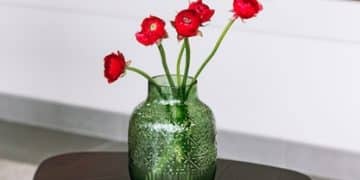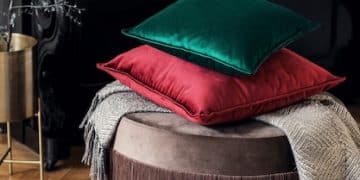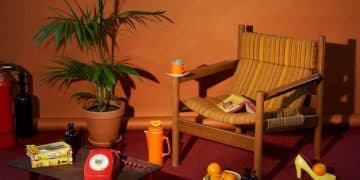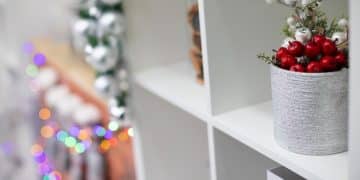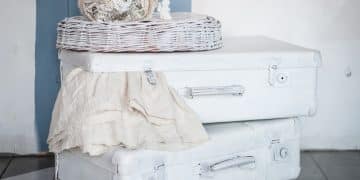The Secret to a Well-Designed Bookshelf: Styling Tips for Interior Design
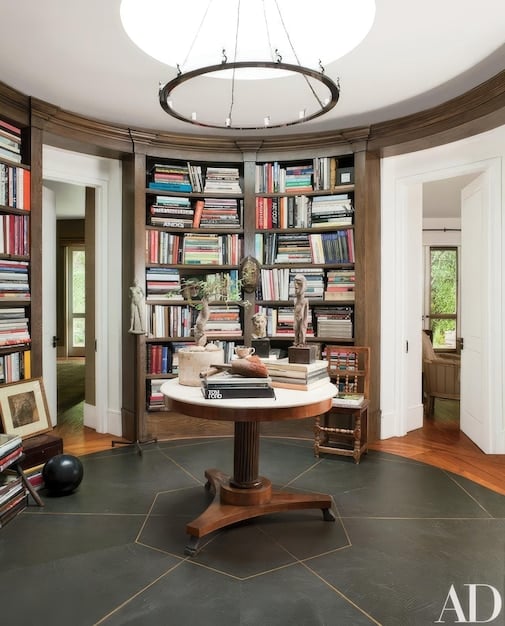
The secret to a well-designed bookshelf lies in blending functionality with aesthetic appeal through strategic organization, incorporating decorative objects, and creating visual balance to reflect personal style and enhance the overall interior design.
Unlocking the secret to stunning interior design often comes down to the details, and few details are as impactful as a well-styled bookshelf. Discover the secret to a well-designed bookshelf: interior design styling tips that will transform your space from ordinary to extraordinary.
The Foundation: Choosing the Right Bookshelf
Before you even think about styling, you need to choose the right bookshelf. The bookshelf itself acts as the backdrop for your design, influencing the entire aesthetic.
Consider the size of your space and how the bookshelf will fit into your room’s overall layout. The material should complement the existing furniture and décor.
Size and Scale
Assess your space to determine the appropriate size of the bookshelf. A large room can handle a substantial, multi-tiered unit, while a smaller space may benefit from a narrow, tall bookshelf.
Material Matters
The material of your bookshelf can speak volumes. Wood offers warmth and traditional appeal, while metal provides a sleek, modern edge. Glass shelves can create an open and airy feel.
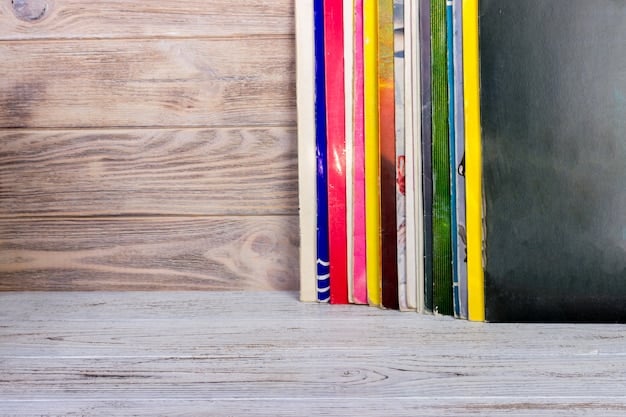
Here are several bookshelf styles based on the material:
- Wooden Bookshelves: Timeless and versatile, fitting well in rustic, traditional, and contemporary settings.
- Metal Bookshelves: Offer a modern, industrial look and are often more durable.
- Glass Bookshelves: Create a minimalist, airy feel, making spaces appear larger.
The choice of bookshelf sets the stage for the style you’re aiming to achieve. By considering size, material, and placement, you lay the foundation for a design that’s both functional and visually pleasing.
Organizing Your Books: Function Meets Aesthetics
The way you organize your books is crucial. It’s not just about storing them; it’s about creating an arrangement that is both practical and aesthetically pleasing. There are several approaches to consider.
Organizing books creatively can transform a simple bookshelf into a stunning focal point. It allows for personal expression and cohesive design.
Color-Coding
Organizing books by color creates a visually striking effect. This method turns your books into a rainbow spectrum, adding a playful and modern touch to your space.
Arranging by Size
Arranging books by size creates a sense of order and neatness. It can be especially effective for bookshelves with varied heights, ensuring a consistent and balanced look.
Here are best practices for effectively organizing your books:
- Consider the spine: Ensure the spines are not damaged and are easy to read.
- Mix orientations: Alternate between vertical and horizontal stacks for visual interest.
- Leave breathing room: Avoid overcrowding the shelves, allowing each book to stand out.
By thoughtfully organizing your books, you can turn a simple storage solution into an eye-catching feature that enhances your interior decor. The key is finding the balance between function and aesthetics.
Adding Decorative Objects: Personalize Your Space
Beyond books, decorative objects play a vital role in styling your bookshelf. These items add personality, depth, and visual interest, making your bookshelf a reflection of your unique tastes.
Integrating decorative pieces thoughtfully can transform your bookshelf into a curated display that enhances the overall aesthetic of your room.
Vases and Planters
Vases bring elegance and sophistication, especially when paired with fresh flowers or greenery. Planters add a natural, organic touch, enlivening the space with vibrant plant life.
Frames and Artwork
Framed photos, prints, and small art pieces insert personality and sentimentality. They can reflect your personal history and artistic preferences.
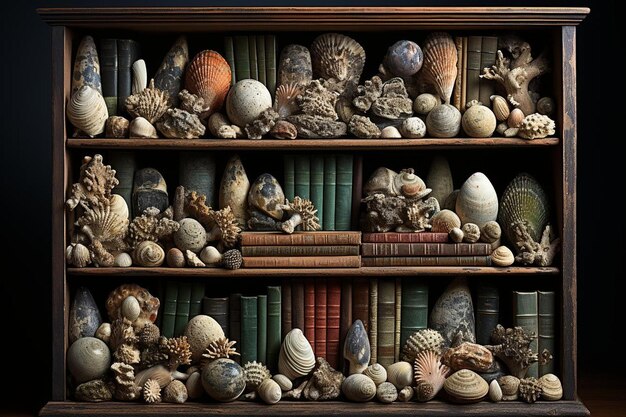
Here are tips for incorporating decorative objects effectively:
- Vary heights: Use objects of different heights to create visual interest.
- Incorporate textures: Mix materials like wood, metal, glass, and ceramics for added depth.
- Reflect personal style: Choose items that resonate with your personality and complement your décor.
Adding decorative objects allows you to personalize your bookshelf, turning it from a simple storage unit into a display of your unique style and interests. It’s about curating a collection that tells a story and enhances the ambiance of your space.
The Art of Visual Balance: Creating Harmony
Creating visual balance is essential for a well-designed bookshelf. Balance ensures that the arrangement is pleasing to the eye and doesn’t feel cluttered or overwhelming.
Achieving harmony involves considering color, weight, and spacing to create a sense of equilibrium and aesthetic pleasure.
Symmetry vs. Asymmetry
Symmetry involves mirroring the arrangement on either side of the bookshelf, creating a formal, structured look. Asymmetry, on the other hand, embraces balance through unequal distribution, offering a more relaxed, dynamic feel.
Color Palette
Stick to a cohesive color palette to ensure harmony. Repeating colors throughout the bookshelf can tie the arrangement together, making it visually appealing.
Key factors that contribute to visual balance include:
- Distribution of weight: Ensure large items are balanced by smaller clusters.
- Color placement: Distribute colors evenly to avoid visual imbalance.
- Negative space: Use empty space to give the eye a break and highlight key items.
Achieving visual balance transforms a bookshelf from a mere storage unit into a carefully orchestrated display. It’s about creating a composition that is both pleasing and engaging, inviting viewers to explore the details.
Lighting Considerations: Highlighting Your Display
Lighting is a powerful tool for enhancing the appearance of your bookshelf. It highlights the textures, colors, and details, making the entire display more captivating.
Thoughtful lighting can dramatically elevate the look of your bookshelf, turning it into a focal point that draws attention and admiration.
Ambient Lighting
Ambient lighting sets the overall mood of the room. Soft, diffused light can create a warm and inviting atmosphere, accentuating the bookshelf as a cozy element.
Accent Lighting
Accent lighting focuses directly on the bookshelf, spotlighting specific items or sections. This can be achieved with strip lights or individual spotlights.
Consider where to place lighting to maximize your decor impact.
- Under-shelf lighting: Creates a subtle illumination that highlights the items above.
- Spotlights: Draws attention to specific artwork or decorative objects.
- Backlighting: Creates a soft glow that accentuates the silhouette of the bookshelf.
Proper lighting can transform your bookshelf into a dazzling focal point. It’s about using light to enhance the visual appeal and bring attention to your carefully curated collection.
Seasonal Adjustments: Keeping It Fresh
Updating your bookshelf seasonally keeps your interior design dynamic and engaging. It allows you to reflect the changing times and maintain a fresh, relevant look.
Seasonal adjustments provide an opportunity to integrate current trends and celebrate the unique characteristics of each season, ensuring your bookshelf remains a lively and expressive part of your decor.
Spring Refresh
In spring, incorporate lighter colors, floral arrangements, and nature-inspired objects to reflect the season’s renewal and freshness.
Autumnal Warmth
In autumn, bring in warmer tones, such as oranges, reds, and browns. Add cozy, earthy elements like pine cones, gourds, and candles.
Seasonal decorating of all styles keeps your home in style all year long.
- Summer vibes: Introduce nautical themes, bright colors, and beach-inspired accessories.
- Winter holiday: Add festive decorations like ornaments, garlands, and winter-themed books.
Seasonal adjustments keep your bookshelf everchanging, reflecting the spirit of the year. It’s about embracing the unique qualities of each season and integrating them into your décor, ensuring your bookshelf remains a fresh and exciting focal point.
| Key Point | Brief Description |
|---|---|
| 📏 Size & Scale | Assess space dimensions for proportional bookshelf size. |
| 🌈 Color Coding | Arrange books by spine color for a visually appealing display. |
| 🖼️ Decorative Objects | Add vases, frames, and plants for personalized charm. |
| 💡 Lighting | Incorporate ambient and accent lighting for visual enhancement. |
Frequently Asked Questions
▼
Assess your space and how the bookshelf will fit into your room’s layout. Ensure it complements the scale of your other furniture and doesn’t overcrowd the area, allowing for a balanced look.
▼
Incorporate vases, planters, framed photos, small sculptures, and personal memorabilia. Vary the textures and heights to create visual interest and showcase your unique style and personality.
▼
Organize by color for a vibrant, modern look, or by size for a neat, orderly appearance. Mix vertical and horizontal stacks to add visual interest, and remember to leave some breathing room on the shelves.
▼
Use a combination of ambient and accent lighting. Ambient lighting provides a general glow, while accent lighting, like strip lights or spotlights, highlights specific items and adds depth to your display.
▼
Consider seasonal adjustments to keep it fresh and relevant. Change colors, themes, and decorative items to reflect the current season, incorporating elements that celebrate the unique characteristics of each time of year.
Conclusion
Mastering the art of bookshelf design involves combining functional organization with creative styling. By selecting the right bookshelf, arranging books thoughtfully, adding personal decorative objects, and balancing the visual elements with appropriate lighting, you can transform a simple storage space into a captivating display that enhances your home’s interior.
